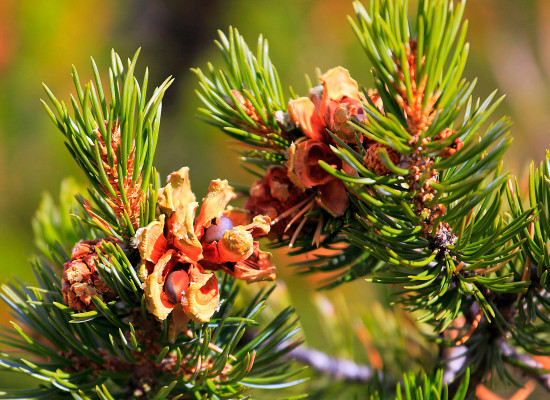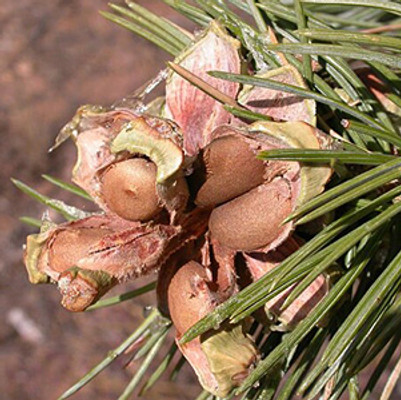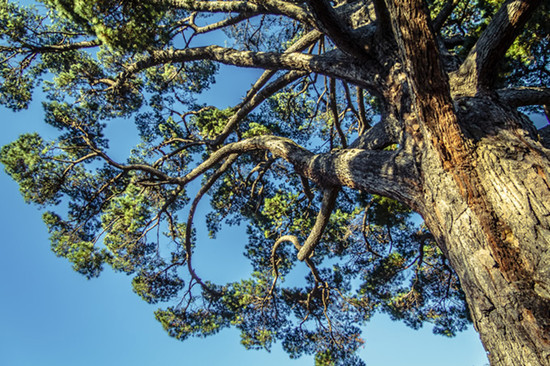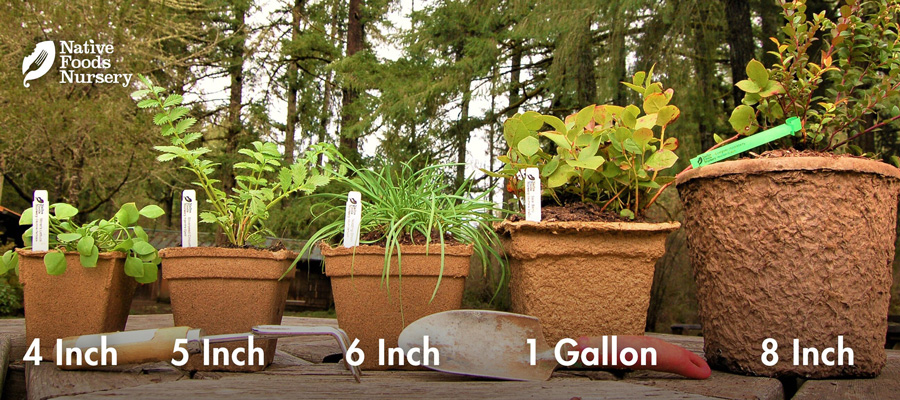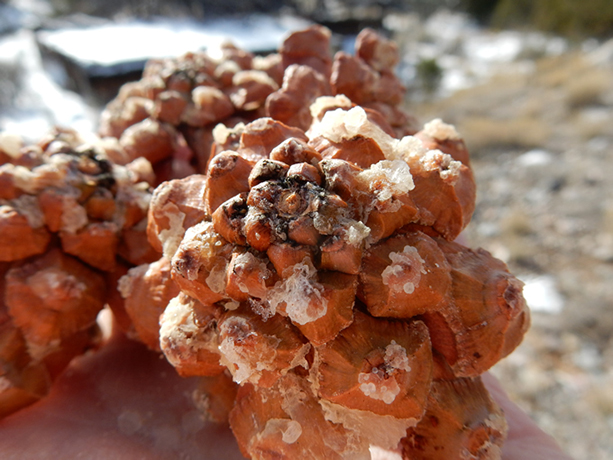Pinyon Pine
- Current Stock:
- 0
- Other Names:
- Colorado/Two-needle Pinyon (edulis), Single-leaf Pinyon (monophylla), Tubape (Pauite, pronounced "TOO-bah-peh")
- Latin Name:
- Pinus edulis & monophylla
Pinyon pines are small, drought-hardy evergreens that produce rich, edible pine nuts and can live for centuries [2]. A potential PNW climate-change-ready all-star for long-term sustainability!
Note (seed source & traits): Our current 23'/24' seedlings come from natural overlap zones of P. edulis and P. monophylla (Arizona/Utah), where hybridization is documented; these special seeds will often have both softer shells (monophylla-like) AND full flavor (edulis-like) [2][12].
Edible Uses
Pinyon nuts are prized for a buttery, mildly sweet flavor and high nutrient density. They’re excellent raw or lightly toasted in pestos, cookies, salads, or over roasted vegetables. Pine nuts are energy-dense (commonly 60–70% lipids) with notable monounsaturated fats—including pinolenic acid—plus vitamin E and polyphenols; studies suggest satiety/lipid benefits are possible but still emerging [5].
Quality note: some imported “pine nuts” (e.g., Pinus armandii) have been linked to transient “pine mouth”; domestic pinyon minimizes that risk [6]. P. monophylla nuts are often easier to hand-crack; P. edulis is commonly roasted in shell for flavor [12].
Ornamental Qualities
A compact, densely foliaged pine for rock gardens and xeriscapes. P. monophylla often shows blue-glaucous needles; P. edulis deeper green; both mature to rounded crowns. Slow growth, compact stature, and extreme drought tolerance suit low-water designs [4].
Pair pinyon with other sun-loving, drought-tough NFN natives—Ceanothus (Redstem or Blue Blossom) as a nitrogen-fixing nurse, Golden Currant for spring bloom and fruit, plus Balsamroot and Ricegrass as living mulch—for a resilient, low-water guild.
Environment and Culture
Range & habitat. P. edulis dominates parts of the Southwest/Colorado Plateau; P. monophylla is widespread across the Great Basin; both occur on dry, rocky slopes with juniper [1][2].
Indigenous stewardship. Indigenous communities across the Southwest continue to harvest, tend, and share pinyon nut traditions as living food and culture; honoring this stewardship—and supporting Indigenous-led restoration—helps sustain both people and place [7].
Pacific Northwest “make it work.” In the PNW, success hinges on drainage and summer-dry siting: plant in full sun on coarse, mineral mounds/berms (pumice/gravel/sandy loam), avoid summer irrigation once established, keep away from lawns/sprinklers, and favor rain-shadow/interior micro-sites west of the Cascades. Heavy, saturated soils are unsuitable [4][10].
Climate outlook (PNW). As summers trend warmer and drier, low-water evergreens like pinyon are a forward-looking choice for PNW landscapes—provided you maximize drainage and minimize summer irrigation; choose the driest, best-drained sites, noting that extreme drought plus bark beetles can cause regional die-offs [2][8][9].
Harvest, Care, and Preparation
Very slow growing; little pruning needed. First cones typically ~25+ years (think of your grandkids!); substantial crops often much later, with masting cycles [3]. Monoecious and wind-pollinated: pollen release late spring–early summer; cones mature/open in early fall of the second (sometimes third) year [3]. Harvest by knocking/twisting nearly mature green cones or shaking just-opening cones onto tarps; air-dry and lightly roast to ease shelling and enhance flavor [11]. After collecting mature cones, spread them to dry until the scales open, shake out the nuts, then toast lightly (about 250–300°F for 10–15 minutes) to loosen shells and deepen flavor before cracking; store shelled nuts refrigerated or frozen to protect the oils [11].
Attributes
Native Range: P. edulis—UT, CO, AZ, NM, eastern NV, etc.; P. monophylla—NV, CA, western UT/AZ, into Baja.
USDA Zones: 4–8 (site/species dependent; edulis often hardy to 4; monophylla commonly 5–9 in dry climates).
Ease of Care: Easy (once established; avoid summer irrigation).
Deer Resistance: Moderate–High (seedlings may be browsed).
Light Requirements: Full sun.
Soil Type: Well-drained, rocky/sandy, slightly acidic to neutral; not for heavy/saturated soils.
Water Requirements: Low; water to establish, then minimal—overwatering can be fatal.
Pollination: Monoecious, wind-pollinated; multiple trees improve nut set.
Bearing Age: ~25+ years to first cones; significant crops commonly later (masting).
Size at Maturity: ~15–35 ft (occasionally taller), broad rounded crown.
Plant Spacing: 12–20 ft (closer in very dry sites).
Phenology: Pollen late spring–early summer; cones mature/open Sept–Oct of 2nd year.
References
[1] USDA PLANTS Database — Pinus edulis (plant profile).
[2] USDA PLANTS Database — Pinus monophylla (plant profile).
[3] U.S. Forest Service, Fire Effects Information System (FEIS) — Pinus edulis species review (distribution, longevity, masting).
[4] Silvics of North America — “Pinyon (Pinus edulis)” (life history, ecology, cone maturation). U.S. Forest Service.
[5] Oregon State University, Landscape Plants — Pinus edulis (horticultural and landscape notes).
[6] Nutrients (2023). “The Beneficial Effects of Pine Nuts and Its Major Fatty Acid, Pinolenic Acid.”
[7] Food & Nutrition Research (2012). “A Trial Investigating the Symptoms Related to Pine Nut Consumption (Pinus armandii).”
[8] Utah State University Extension — Native American Uses of Utah Forest Trees.
[9] Great Basin National Park (NPS) — Pine Nut Gathering.
[10] Woody Plant Seed Manual (USDA Forest Service, Agriculture Handbook 727, 2008) — Seed and cone biology; two-year maturation.
[11] Breshears, D.D., et al. (2005). “Regional vegetation die-off in response to global-change-type drought.” Proceedings of the National Academy of Sciences.
[12] Utah State University — Range Plants: Pinyon, Twoneedle (Pinus edulis) and Singleleaf Pinyon (Pinus monophylla).
Pot Sizing Guide
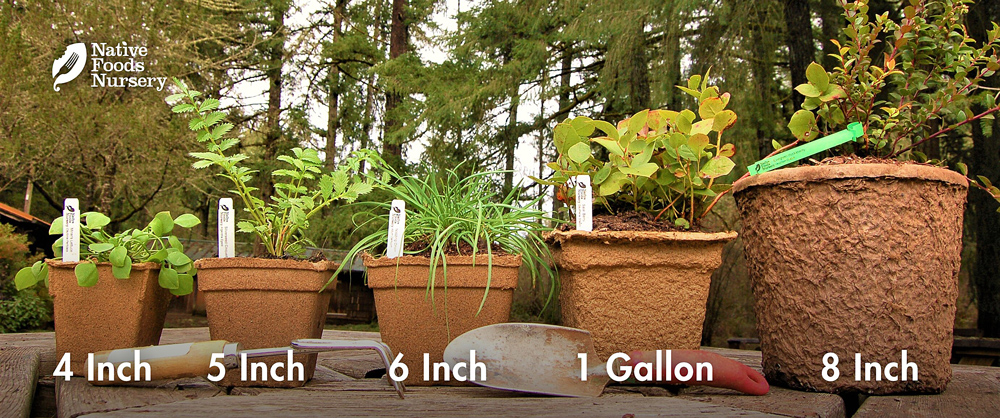
Planting Guide: Pinyon Pine (Pinus edulis × Pinus monophylla)
Tip: Think “high desert.” Give pinyon full sun, fast drainage, and a summer-dry regime; once established, avoid irrigation and let deep roots do the work.
Choosing a Site
Light: Full sun (8+ hours) is best for dense growth and cone production.
Soil: Fast-draining, mineral soils—gravelly/sandy/rocky loam. If you have heavier soil, plant on mounds/berms amended with coarse mineral material (pumice, gravel) rather than compost.
Space: 12–20 ft between trees (closer only in very dry, low-vigor sites).
Wind: Handles heat and wind; choose an open, sun-baked exposure.
Neighbors: Pair with other dry-adapted natives; avoid lawns and irrigated beds.
Pacific Northwest Notes
Rain shadow & aspect: West of the Cascades, use the driest micro-sites—south or west slopes, rain-shadow pockets, gravelly banks, or under deep eaves. East of the Cascades, typical sunny, well-drained sites work well.
Drainage first: If water lingers after storms, build a 12–18 in. berm of coarse, mineral soil and plant on top. Keep organic mulch light and away from the trunk.
Irrigation: Water for establishment only, then taper off; summer watering beyond year two can stress or kill pinyon in the PNW. Keep drip lines and sprinklers far from the root zone.
Future-ready: As summers trend warmer and drier, pinyon can be a strong low-water choice for PNW landscapes when sited on the driest, best-drained ground.
Planting Steps
Timing: Plant in fall (preferred in the PNW) or early spring once soil is workable.
Hole: Dig wide and shallow; roughen sides. Backfill mostly with native soil plus 20–40% coarse mineral material (pumice/gravel). Avoid heavy compost or manure.
Set: Place at the same depth as in the pot. Do not bury the root collar; spread roots gently.
Backfill & water: Backfill, then water deeply once to settle soil and remove air pockets.
Surface: Top with a thin mineral mulch (gravel/pumice). Keep bark mulch, if used at all, very light and a few inches from the trunk.
Watering & Care
Establishment (year 0–2): Deeply water every 10–14 days in dry spells, then allow soil to dry fully. Aim for infrequent, deep watering rather than frequent sips.
After establishment: Withhold irrigation except in severe drought; pinyon is adapted to summer-dry conditions.
Feeding: None needed in most soils. If growth is extremely poor, use a very light, low-nitrogen, mineral-forward amendment once in spring.
Pruning: Minimal. Remove dead or rubbing twigs in late winter; avoid heavy shaping.
Companions: Ceanothus (nitrogen-fixing nurse), Golden Currant, yarrow, and native bunchgrasses make a resilient, low-water guild around pinyon.
Protection
Wildlife: Young plants may be browsed—use shelters or fencing for the first few years.
Soil moisture: Do not allow sprinklers or roof downspouts to saturate the root zone.
Weeds: Keep grasses and weeds cleared in a 2–3 ft radius to reduce competition.
Pollination & Bearing
Flowers/cones: Monoecious and wind-pollinated; male and female cones form on the same tree.
Timing: Pollen release typically late spring to early summer. Cones mature and open in early fall of the second (sometimes third) year after pollination.
Patience: First cones often appear around 20–30+ years; substantial crops may be much later and occur in “mast” years.
Harvest & Preparation
How to harvest: Knock/twist nearly mature green cones (or shake just-opening cones) onto a tarp. Air-dry until scales open, then extract the nuts.
Kitchen prep: Toast lightly (about 250–300°F for 10–15 minutes) to loosen shells and deepen flavor before cracking. Store shelled nuts refrigerated or frozen to protect the oils.

